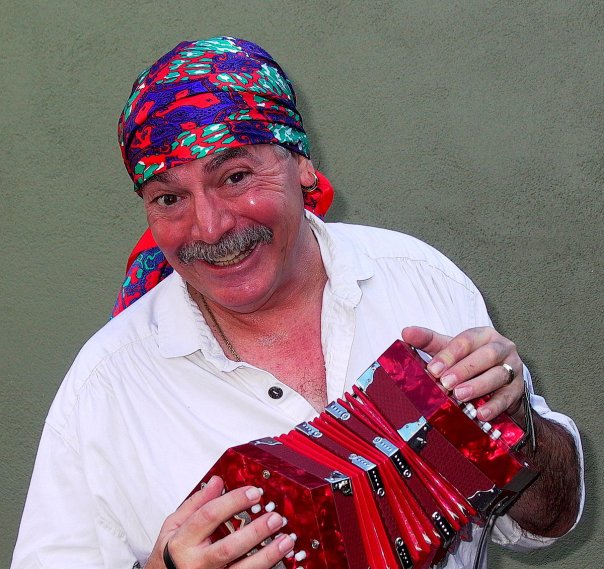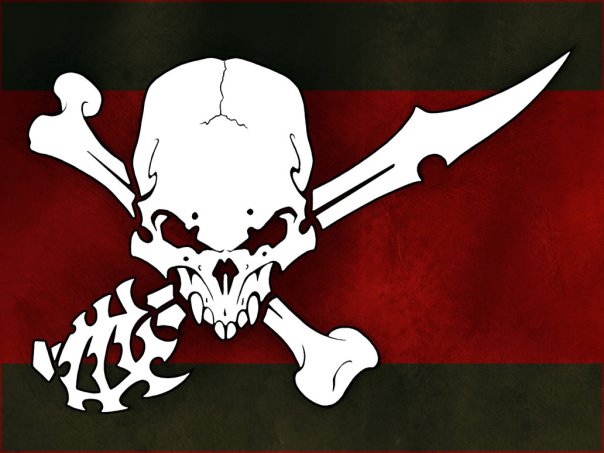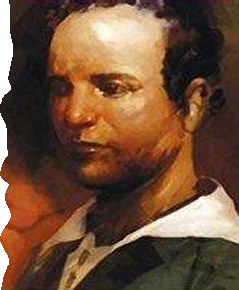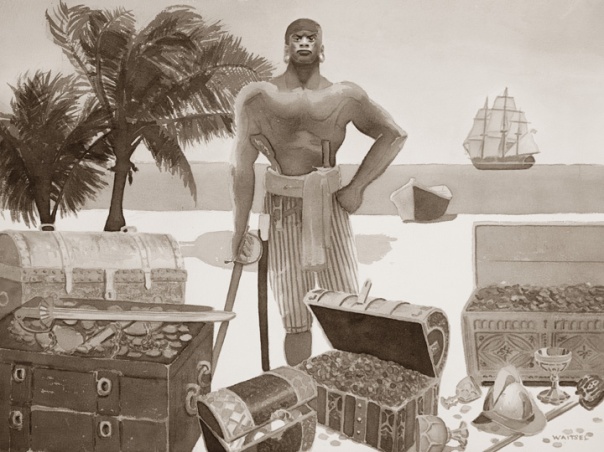Blog Archives
Talk Like a Pirate, ya lubber, or Shove Off!
International Talk Like a Pirate Day!
From Tim Collier:
Ah, well. Designing pirates for work, and sketched this out as a possible flag for the undead pirate, Razig.
The term “Jolly Roger” is actually from the French, “Jolie Rouge,” or “pretty red (flag)”. At the dawn of the Golden Age of Piracy, there weren’t any skull-and-crossbones banners, so pirates generally flew a solid red flag — the flag for “No Quarter” — no mercy asked, none granted. After a while, captains began to customize their happy red flags with skulls, hourglasses, bleeding hearts, swords, severed heads… Edward Teach (Blackbeard) went so far as to fly a flag depicting himself and Death drinking a toast. And most of the flags, for the sake of visibility, became black. Tadaaah! ![]()
This image, although free to use as a wallpaper, is ©2006 Tim Collier. There are shirts and stuff here, and I might even see about printing up some real flags soon… ![]() So please be kind and respect the copyright, OK? Thankee!
So please be kind and respect the copyright, OK? Thankee!
19th Century Spanish Pirate Benito de Soto
“Benito Soto Aboal (April 22, 1805, Pontevedra – January 25, 1830, Gibraltar) was a Galician pirate, and captain of the Burla Negra (“Black Joke”).
“Benito de Soto was the most notorious of the last generation of pirates to plunder shipping in the Atlantic, one of those arising from the ending of the Napoleonic Wars.
“De Soto served on an Argentinian slave ship before leading a mutiny off the coast of Angola in 1827. When 18 of the crew declined to participate they were cast adrift off in an open boat.
“Having renamed the vessel the Burla Negra, de Soto crossed the Atlantic, where he sold stolen cargo of slaves in the Caribbean, and then sailed south, attacking English, American, Spanish and Portuguese ships along the South American coast. From 1830 the Burla Negra also ventured eastwards into the Atlantic to intercept vessels returning from India and the Far East.
“He proved to be one of the most bloodthirsty pirates of any age, murdering crews who fell into his hands and sinking their ships.
The most infamous episode in de Soto’s career came on 19 February 1828, when the Burla Negra happened upon the Morning Star en route from Ceylon to England. After killing some of the passengers and crew with cannon fire, de Soto murdered the captain and took possession of the ship.
“Many of the captured crew were killed, while women passengers were raped before being locked in the hold with the rest of the survivors. De Soto then scuttled the ship, thinking to leave no evidence of the attack, but the imprisoned survivors managed to escape and prevent the Morning Star from sinking until a passing merchant vessel rescued them the following day.
“De Soto’s crimes caught up with him after the Burla Negra struck a reef and was wrecked off Cadiz. He and his men headed for Gibraltar, but they were recognized and taken for trial. De Soto was hanged. His head was then stuck on a pike as a warning to others.”
–wikipedia.com
More info here: http://www.thepirateking.com/books/books_piratesownbook_de_soto.htm
Black Caesar — African pirate, one of Blackbeard’s men
“Black Caesar (died 1718) was an 18th-century African pirate. For nearly a decade, he raided shipping from the Florida Keys and later served as one of Captain Blackbeard’s chief lieutenants aboard the Queen Anne’s Revenge. He was one of the surviving members of Blackbeard’s crew following his death at the hands of Lieutenant Robert Maynard in 1718.
Caesar’s Rock, one of three islands located north of Key Largo, is the present-day site of his original headquarters and named in his honor.
Black Caesar, according to traditional accounts, was a prominent African tribal war chieftain. Widely known for his “huge size, immense strength, and keen intelligence”, he evaded capture from many different slave traders. Caesar was finally captured when he and twenty of his warriors were lured onto a ship by a slave trader.
“Showing him a watch, the trader promised to show him and his warriors more objects which were “too heavy and too numerous to bring on shore” if they came aboard his ship. He enticed them to stay with food, musical instruments, silk scarves and jewels, however he had his men raise anchor and slowly sail away. When Caesar discovered what was happening, he and his men attempted to charge their captors but were driven back by the well-armed sailors using swords and pistols.
“Although it took a considerable length of time for him and his warriors to accept their captivity, he was eventually befriended by a sailor who was the only man Black Caesar would accept food and water from.
“As they neared the coast of Florida, the sudden appearance of a hurricane threatened to destroy the ship on the Florida Reefs.
“Recognizing the ship’s imminent destruction, the sailor snuck below decks and freed Caesar. The two then forced the captain and crew into a corner, most likely at gunpoint, and boarded one of the longboats with ammunition and other supplies. The wind and waves pushed them to shore where they waited out the storm, apparently the only survivors of the doomed ship.
“They soon began using the lifeboat to lure passing ships which stopped to give assistance. While posing as shipwrecked sailors, they would sail out to the vessel offering to take them aboard. Once they were close to the vessel, they brought out their guns and demanded supplies and ammunition, threatening to sink the ship if they were refused. He and the sailor continued this ploy for a number of years and amassed a sizable amount of treasure which was buried on Elliott Key. However, he and the sailor had a falling out over a young woman the mate had brought back from one of the ships they had looted. Fighting over her, Caesar killed his longtime friend in a duel and took the woman for his own.
“He began taking on more pirates over time and soon was able to attack ships on the open sea. He and his crew were often able to avoid capture by running into Caesar Creek and other inlets between Elliot and Old Rhodes Key and onto the mangrove islands. Using a metal ring embedded in a rock, they ran a strong rope through the ring, heel the boat over, and hide their boat in the water until the patrol ship or some other danger went away. They might also lower the mast and sink the ship in shallow water, later cutting the rope or pumping out the water to raise the boat and continue raiding. It is thought that he and his men buried 26 bars of silver on the island, although no treasure has ever been recovered from the island.
“He apparently had a harem on his island, having at least 100 women seized from passing ships, as well as a prison camp which he kept prisoners in stone huts hoping to ransom them. When leaving the island to go on raids, he left no provisions for these prisoners and many eventually starved to death. A few children reportedly escaped captivity, subsisting on berries and shellfish, and formed their own language and customs. This society of lost children give rise to native superstition that the island is haunted.
“During the early 18th century, Caesar left Biscayne Bay to join Blackbeard in raiding American shipping in the Mid-Atlantic serving as a lieutenant on his flagship Queen Anne’s Revenge. In 1718, after Blackbeard’s death battling with Lieutenant Robert Maynard at Ocracoke Island, he attempted to set off the powder magazine as per Blackbeard’s instructions. However, Caesar was stopped by one of the captives who tackled him as prepared to light a trail of gunpowder leading to the magazine. He struggled with the man below decks until several of Maynard’s sailors were able to restrain him. Taken prisoner by Virginian colonial authorities, he was convicted of piracy and hanged in Williamsburg, Virginia.”
–from Wikipedia.com
–illustration from http://www.waitsel.com/blog/2012/01/my-latest-work-pirate-illustrations-for-the-travel-channel/
Pirate Bloopers
September 19th be gaining on us…Here are some bloopers from Pirates of the Caribbean.
Living the Pirate Code
PRESS RELEASE For Immediate Release “Living the Pirate Code” Book Launch Coincides with Talk Like a Pirate Day on September 19!
(Mikazuki Publishing News) Sep 4th 2013 – “Living the Pirate Code: The World’s Greatest Pirates” is the newest book published by international book publisher Mikazuki Publishing House. “Living the Pirate Code”(ISBN-13:978-1937981013) is a historical non-fiction that revolves around notorious pirates, their way of life, their battles, and their adventures for gold. Interesting characters are featured such as Mrs.Cheng, a female pirate in China that lead 70,000 pirates is discussed in detail as is Stede Bonnet the world’s first aristocratic pirate.
The popularity of pirates has risen in recent years with the creation of films and toys that sell to pirate lifestyle aficionados. This has caused a rise in the amount of pirate festivals that are being held in the United States, Canada, and the United Kingdom. Attendees to pirate festivals range from a few hundred to larger ones that attract thousands of pirate lovers. International Talk Like a Pirate Day is an important annual event for pirate fans held on September 19th and it was originally started by two individuals from America’s Pacific northwest, although it is not an officially recognized holiday.
On September 19th of every year, individuals only speak using pirate lingo. This has spurred many websites on the internet that focused on pirate fans, to have to create an English to Pirate Talk translator for mastering pirate vernacular and social networking sites such as Facebook allow users to set their default language to Pirate English. “Living the Pirate Code”(ISBN-13:978-1937981013) has a retail price of $7.99. For more information visit www.MikazukiPublishingHouse.com
Mary Read and Anne Bonny the most famous female pirates:
Anne Bonney and Mary Read are the most famous — and ferocious — women pirates in history, and they are the only ones known to have plied their trade in the Western Hemisphere.
Anne Bonney, born in County Cork, Ireland, was the illegitimate daughter of lawyer William Cormac and his housemaid. They immigrated to America after Anne’s birth in the late 1600s and settled on a plantation near Charleston, South Carolina. A headstrong young woman “with a fierce and courageous temper,” she eloped with a young ne’er-do-well, James Bonney, against her father’s wishes. James took her to a pirates’ lair in New Providence in the Bahamas, but in 1718, when Bahamian Governor Woodes Rogers offered the King’s pardon to any pirate, James turned informant. Anne was disgusted with his cowardice and soon after, she met and fell in love with the swaggering pirate Captain Jack Rackham. Disguising herself as a male, she began sailing with him on his sloop Vanity, with its famous skull-and-crossed-daggers flag, preying on Spanish treasure ships off Cuba and Hispaniola. It is reported that she became pregnant by Jack and retired from piracy only long enough to have her baby and leave it with friends in Cuba before rejoining him and her adventurous life on the high seas.
Mary Read was born at Plymouth, England, about 1690. Her mother’s husband was a sea-faring man who left on a long voyage and was never heard from again. He’d left his wife pregnant and she gave birth to a sickly male child who died soon after the illegitimate birth of his half-sister, Mary. The mother waited years for her husband to return and when her money ran out, she took Mary to London to appeal to her mother-in-law for financial help. She knew this old woman disliked girls, so she dressed Mary in boy’s clothes and made her pretend to be her son. The mother-in-law was fooled and promised a crown a week to help support them. Mary continued to masquerade as a boy for many years, even after the old woman died and the financial aid ended.
Then a teenager, Mary was hired out as a footboy to a French woman. But according to history, “here she did not live long, for growing bold and strong, and having also a roving mind, she entered herself on board a man-of-war, where she served some time; then quitted it.” Still disguised as a male, she enlisted in a foot regiment in Flanders and later a horse regiment, serving in both with distinction. She fell in love with a fellow soldier, disclosed her true sex, and began dressing as a female. After their marriage, she and her husband became innkeepers, owning the Three Horseshoes near the castle of Breda in Holland. Unfortunately, he died young and her fortunes soon dwindled.
She knew that life in the 1700s was much easier as a man than as a woman, so she reverted back to men’s clothing and started her life over, this time going to sea on a Dutch merchant ship heading to the Caribbean. On one voyage, the ship was commandeered by English pirates with whom she sailed and fought until they accepted the King’s pardon in 1718 and began operating as privateers. Soon afterwards, their ship was overtaken by Captain Jack Rackham’s Vanity and, bored of the legitimate life, she again turned pirate. Anne Bonney was already part of Rackham’s crew, and she and Mary quickly discovered each other’s cross-dressing secret and became close friends. Despite her tough exterior, Mary found a lover on board and is said to have saved his life by protecting him from a threatened duel. She picked a fight with his opponent first and, with deadly use of her sword and pistol, ended his life before he could harm her husband-to-be.
Both Anne and Mary were known for their violent tempers and ferocious fighting, and they shared a reputation as “fierce hell cats.” Their fellow crewmembers knew that — in times of action — no one else was as ruthless and bloodthirsty as these two women were. Captain Jack, nicknamed “Calico Jack” for his love of colorful cotton clothing, was a well-known pirate in those days, but his reputation has survived through the ages primarily because of these two infamous women pirates on his crew.
In late October 1720, Rackkam’s ship was anchored off Point Negril, Jamaica, the pirates celebrating recent victories in their typical hard-drinking tradition. Suddenly a British Navy sloop — the man-o-war Albion, headed by Captain Jonathan Barnet — surprised them. The drunken male pirates quickly hid below deck, leaving only Anne and Mary to defend their ship. The women yelled at their pirate mates to “come up, you cowards, and fight like men,” and then angrily raged against them, killing one and wounding several others. But the women were eventually overwhelmed by the British Navy, and the entire crew was captured and taken to Jamaica to stand trial.
Captain Jack and the male members of his crew were tried on November 16, 1720, and were sentenced to hang. Anne was allowed to visit her lover in his cell before his execution, and instead of the consoling, loving words he was undoubtedly expecting, her scathing comments live on throughout history: “Had you fought like a man, you need not have been hang’d like a dog.”
Anne and Mary were tried one week after Rackham’s death and were also found guilty. But at their sentencing, when asked by the judge if they had anything to say, they replied, “Mi’lord, we plead our bellies.” Both were pregnant, and since British law forbade killing an unborn child, their sentences were stayed temporarily.
Mary is said to have died of a violent fever in the Spanish Town prison in 1721, before the birth of her child. Other reports say she feigned death and was sneaked out of the prison under a shroud.
No record of Anne’s execution has ever been found. Some say that her wealthy father bought her release after the birth of her child and she settled down to a quiet family life on a small Caribbean island. Others believe that she lived out her life in the south of England, owning a tavern where she regaled the locals with tales of her exploits.
And yet others say Anne and Mary moved to Louisiana where they raised their children together and were friends to the ends of their lives.
Taken From: http://www.bonney-readkrewe.com/legend.html









